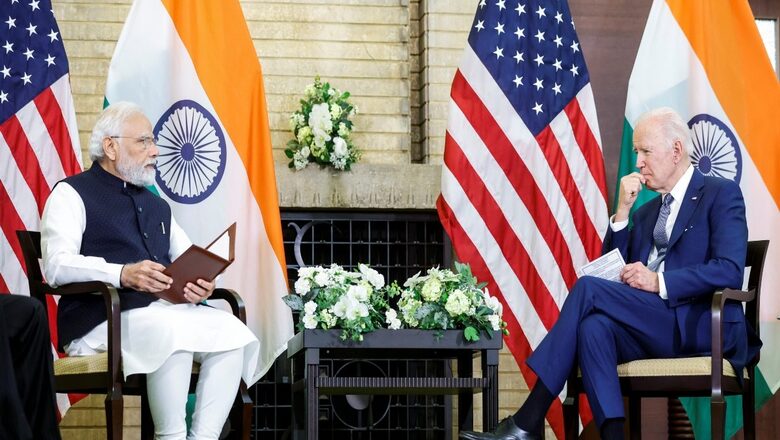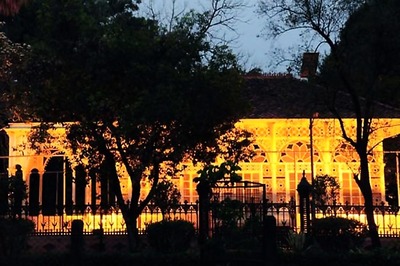
views
There is a major upgrade in the Indo-American relationship. Not only did Prime Minister Modi’s state visit yield a cornucopia of high technology, trade, joint venture and defence manufacturing benefits, but it is on a scale such that the whole world will have to recalibrate how it considers India going forward. Our country has long been constrained to be in first or second place when it comes to the purchase of foreign armaments involving billions of dollars. However, the picture is beginning to change because of a strong Aatmanirbhar push lately.
Indian defence production values were in excess of Rs 1 lakh crore for the first time in fiscal 2022, up from Rs 95,000 crore in fiscal 2021 and just Rs 54,951 five years ago. India is now targeting Rs 1,75,000 crore in indigenous defence production by fiscal 2024.
The technology transfer and joint venture format which it now pushes vigorously should greatly enhance the indigenous defence manufacturing effort. India has also developed a defence equipment export target of $5 billion by 2025, up from $1.5 billion achieved in fiscal 2022. This process is now starting to form a pattern. The accountants will have to work out the savings against fully-built imports.
On June 8, 2023, after interminable negotiations, India’s government-owned Mazagon Docks (MDL) and Germany’s ThyssenKrupp Marine Systems (TKMS) signed an MoU and became front runners (in competition with the Spanish and the South Koreans), to submit a joint bid. It is for an over Rs 42,000 crore project to build six diesel-electric submarines. The German firm will provide the engineering, design, and consultancy support for the joint venture instead of selling much more expensive fully built submarines from German dockyards. The competition is also agreeable to collaborate, and this may have forced the German hand. These submarines for the Indian Navy will have operation AIP, which extends the underwater endurance and makes conventional submarines as good as they get. At present, India’s L&T will possibly make the AIP componentry for this.
How much of Rs 42,000 crore will fall to the Indian manufacturing effort?
The Indian submarine fleet is depleted and has 10 old submarines — six Russian Kilo class, four German HDW, and six new Scorpene class submarines, built in collaboration with the French for Rs 23,000 crore (again, how much did we save by this?), and two nuclear submarines built in collaboration with the Russians (ditto). We have two aircraft carriers. One is a retired British carrier retrofitted in Russia at great expense, cost overruns and immense delays and the other is built in India, albeit with Russian help but at target prices and dates. India can now make another and yet another 45,000-ton aircraft carrier by itself if need be. But the days of aircraft carriers may be coming to an end, overtaken by UAV and drone technology, missiles, and even nuclear submarines.
The Chinese, by way of contrast, have over 50 diesel-electric submarines and 10 nuclear ones. It is also building eight diesel-electric Yuan class submarines for Pakistan.
The fact that we are buying 31 armed Predator drones now helps us keep track of the Chinese ships and submarines in the Indian Ocean, the Arabian Sea and the Bay of Bengal.
There is now unprecedented progress in military manufacturing in collaboration with the US. The agreements have come thick and fast during PM Modi’s visit between June 21-24, 2023. It is now down to equally dynamic implementation on both sides before the negative lobbies slow it down to a snail’s pace even if they can’t actually scrap it.
It is a game-changer because the US has decided to get off the fence with regard to military cooperation with India, despite Indian reluctance to become a formal US ally in the NATO Plus mould.
The handing over of the GE F414 technology could mean two bites of the cherry. First, over 350 to 500 engines for the Tejas MK2 and the AMCA MK1, over the next decade or more. And perhaps, who knows, the shifting of the F/A-18 Super Hornet Assembly line that uses the GE F414, alongside more than 60,000 of the engines exported elsewhere, to a much less expensive country like India. This could mean sales to India for early requirements such as those urgently needed for our aircraft carriers, and then US exports of upgraded versions of this venerable old plane, from the assembly line in India. A lot, of course, depends on the latest avionics and the firepower the planes are equipped with.
The imminent induction of GE-F414INS6 turbofan fighter engines for the Tejas MK2, in the 98 KiloNewton thrust class is now a done deal, but for some ratification by the US Congress. The MoU agreement was signed on June 22 between GE and HAL. The engines, of which eight are already in India for the Tejas MK2 prototypes, will certainly speed up India’s under-production medium combat aircraft, the Tejas MK2. These engines are tried and tested, and currently power both the American F/A-18 Super Hornets, upgraded already from the F-16s, and Swedish Gripen fighters. GE has already supplied the less powerful 75 GE-404 engines for the Tejas MK1A, and another 99 are on order.
Only four countries — US, Britain, France and Russia — design and manufacture commercial and military jet engines, including hypersonic and supersonic ones for the latter. The US via General Electric (GE) and Pratt & Whitney (P&W), Britain via Rolls Royce, France through Safran, and Russia via Klimov, NPO Saturn and Aviadvigatel. The reliability of the Russian engines is not as good as the rest and of late, there were complaints on the P&W commercial aircraft engines by GoAir.
The state-of-the-art 31 armed MQ 9B Sea Guardian/Reaper/Predator drones (they go by several names), with Hellfire missiles and guided laser bombs capable of flying and loitering at 40,000 feet are to be bought for $3.5 billion. They have over-the-horizon surveillance and attack capability and have delivered great results in the Afghanistan theatre against the Taliban. With MRO facilities to be set up in India, DRDO should likewise gain the experience to build such drones in the future and benefit their own drone manufacturing programme.
15 of the Predators are intended for the Indian Navy facing a challenge from increasing Chinese activity in the Indian Ocean, the Arabian Sea and the Bay of Bengal. Eight each are for the Army and the IAF. All will be under the new tri-services commands.
These spectacularly capable drones will hugely upgrade India’s long-range intelligence surveillance and reconnaissance (ISR), and because they are armed, they strike missions when called for, along the LaC, LoC and elsewhere. India currently has just two of these for naval reconnaissance only, on lease from America since 2020. Some 60 percent of the new Predator parts are to be manufactured by the Kalyani Group.
The American towed 155 mm Howitzers already in use in India, the M777, are on offer to be upgraded with precision-guided long-range ammunition. India already has 145 of these, of which 120 were made by Mahindra Defence Systems in a business arrangement with America’s BAE Systems. These lighter howitzers can be taken to mountain areas by helicopter if need be. The Americans have also offered their Stryker eight into eight-wheeled drive V-hull armoured infantry vehicle that saw action in Afghanistan. It is armed with a 30mm cannon and a 105mm mobile gun. India will be interested, again, if it comes with the transfer of technology and local manufacturing clauses. An American $2.7 billion chip unit from Micron is about to be established in India, probably in Gujarat. In addition, Applied Materials will invest $400 million to build a collaborative engineering centre in Bengaluru to develop and commercialise technology for semiconductor manufacturing equipment.
Boeing, reacting to large commercial aircraft orders from India, will also set up a $100 million pilot training centre. Google plans to invest $10 billion in India’s digitisation fund with a new Global Fintech Centre in GIFT City, Gujarat. There will be more in the semiconductor field, an urgent strategic area for both India and America. A pact to also collaborate on quantum computing and artificial intelligence is being signed. Collaboration on hypersonic missiles with the US is also on the cards. There will be a joint manned mission to the moon by 2025, between ISRO and NASA and other space cooperation. There are pacts on communications inclusive of 5G and 6G, and a new radio protocol. The 4 lakh odd Indian people on H-1B visas will have them renewed in America without having to leave and then re-enter the country in future. America will open new consulates in Ahmedabad and Bengaluru, and India will open a new consulate in Seattle.
The list goes on, now that four ‘foundational agreements’ signed over the last few years have got the legal requirements out of the way, with two more on the anvil to eliminate future impediments.
India has also signed the new-fangled Global Mineral Alliance to secure access to the world’s minerals without Chinese hegemony creating monopolies, despite their nearly 90 percent hold on present supplies. But there are several other untapped and partially exploited sources. India may also seek US know-how to extract its new finds of Lithium in Jammu and other rare earths it is rich in, despite importing all its requirements of both at present.
America has already sold $21 billion in defence equipment over the last 15 years, but this now is the great leap forward, to paraphrase Chairman Mao. Trade with India, currently at $195 billion, is sought to be increased to $500 billion to offset some of the difficulties of still having a trade of $700 billion with China, despite increasing prickliness and a general lack of trust between the two.
Another fighter engine, larger, more powerful, in the 110 KiloNewton thrust class, is expected to come from another joint venture with GE next, for India’s forthcoming 5th generation Advance Medium Combat Aircraft (AMCA), for its MK2 version stealth fighter.
Prime Minister Modi’s US visit, after the exchange of gifts including a laboratory grown 7.5 carats ‘green’ diamond, using solar power for energy, and exports of $1.67 billion of such diamonds, mostly to the US. There was a 19-gun salute, 5,000 Indian-Americans invited to assemble on the White House Lawns, bilateral meetings, a private dinner in the White House, another with the Vice President and the Secretary of State, a state dinner in which India’s thrust on millets was honoured, an address to the Joint Houses, meetings with the giant corporation heads of IT, and of course, the leitmotif mega diaspora event.
Before getting into the government-to-government business in Washington, on the very first day of the visit, Prime Minister Modi met with several business heads in New York, including the colourful Elon Musk. This might mean a prestigious Tesla plant in India for the famous high-end electric cars. Musk also spoke of his satellite-based internet system, Starlink, which has proved itself very useful in the Ukraine War.
PM Modi also celebrated the 9th International Yoga Day on the lawns of the UN in New York. This, with diplomats from 135 countries, and others, such as Hollywood actor and pro-Tibet activist, 73-year-old Richard Gere.
The usual human rights lectures and homilies of gratuitous advice from the American establishment, prompted by anti-India lobbies, were put on hold this time. Although some members of the Press, and, notably, former President Obama, did raise the usual propaganda-based questions. However, US National Security Adviser, Jake Sullivan said, very diplomatically that each country has its own challenges to deal with, and admitted America has its own human rights challenges too.
The US state visit ended after a final diaspora event at the Ronald Reagan Centre in Washington. It was followed by a short state visit to Egypt, the first by an Indian prime minister since 1997. This was on June 24-25. In Egypt, PM Modi visited a venerable Shia mosque, the 11th-century Hakim Mosque from the Fatimid Dynasty, traced as the origin of the Indian Dawoodi Bohra Community. The mosque has been gradually restored by the Bohra community right from the 1970s. He also visited the Heliopolis Memorial to 3,799 fallen Indian soldiers in World War I. This Egypt visit is reciprocal after President El Sisi came to New Delhi as Chief Guest for the Republic Day functions in January 2023. It holds great promise because Egypt wants to buy and joint venture on a slew of military equipment, including establishing an assembly line with India’s HAL for Tejas aircraft.
Indian defence delegations have visited India some 30 times in the last two years, and the Egyptians have also come to India some seven times. Joint military exercises have been conducted for the first time. Trade with Egypt has been modest but shows great potential for both sides. Egypt is a guest country in the ongoing G-20 activities in India under India’s 2023 Chairmanship. On its part, Egypt has offered India space at the Suez Canal SEZ to boost Indian overseas trade.
This Egypt visit comes in the backdrop of an MoU just signed between India’s Hindustan Aeronautics Limited (HAL) and Argentina’s Fabrica Argentina de Aviones (FAdeA) at the Paris Air Show. It lays out an intent to collaborate in the aerospace sector, to set up first a maintenance, repair and overhaul facility (MRO). Argentina has shown interest in buying 15 of the Tejas MK1A and other aircraft on the HAL platform. This, while Argentina is also considering the Chinese JF-17.
The writer is a Delhi-based political commentator. The views expressed in this article are those of the author and do not represent the stand of this publication.


















Comments
0 comment